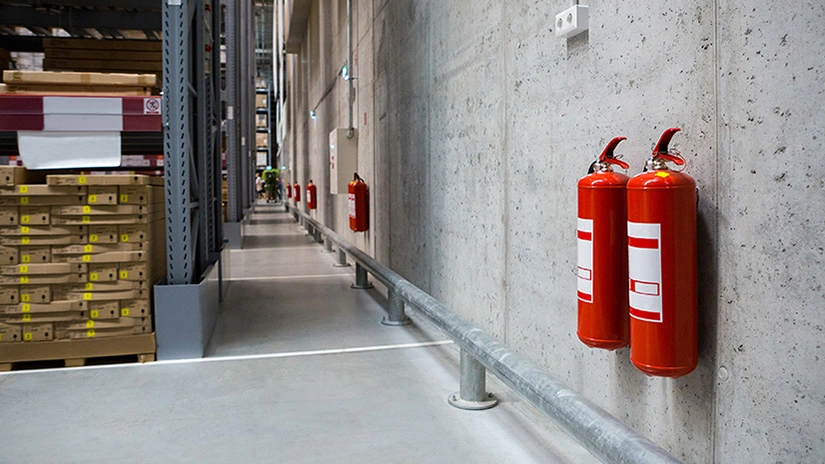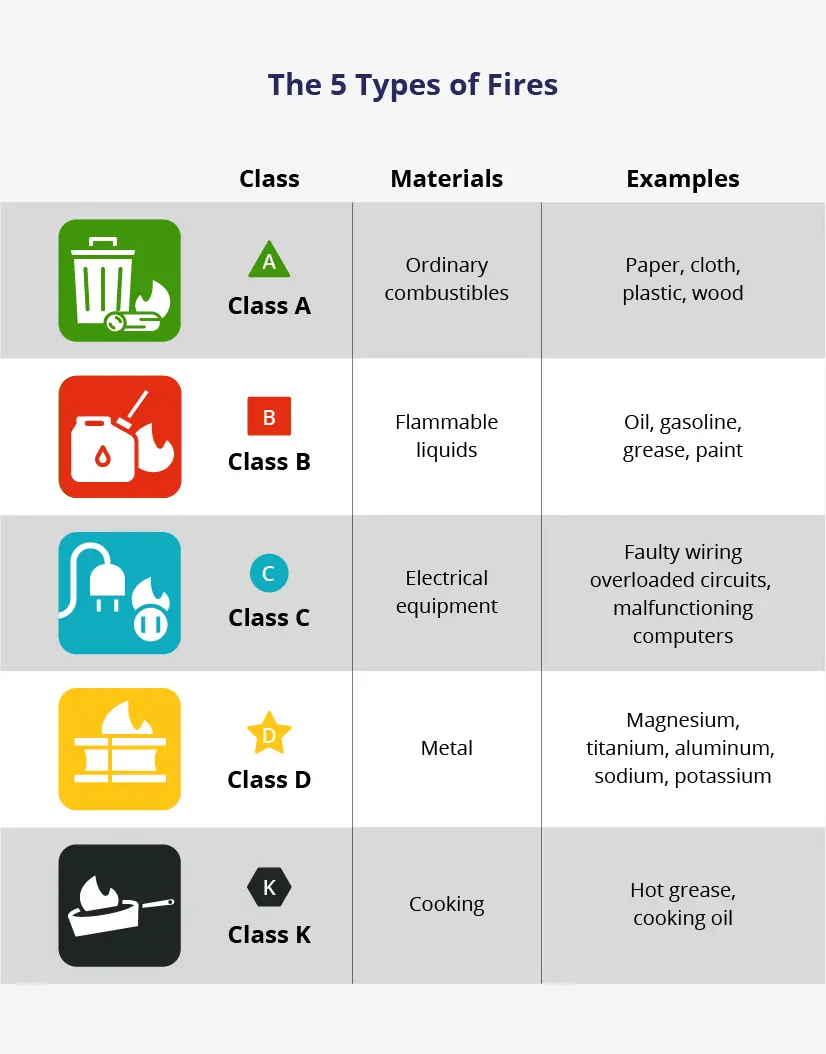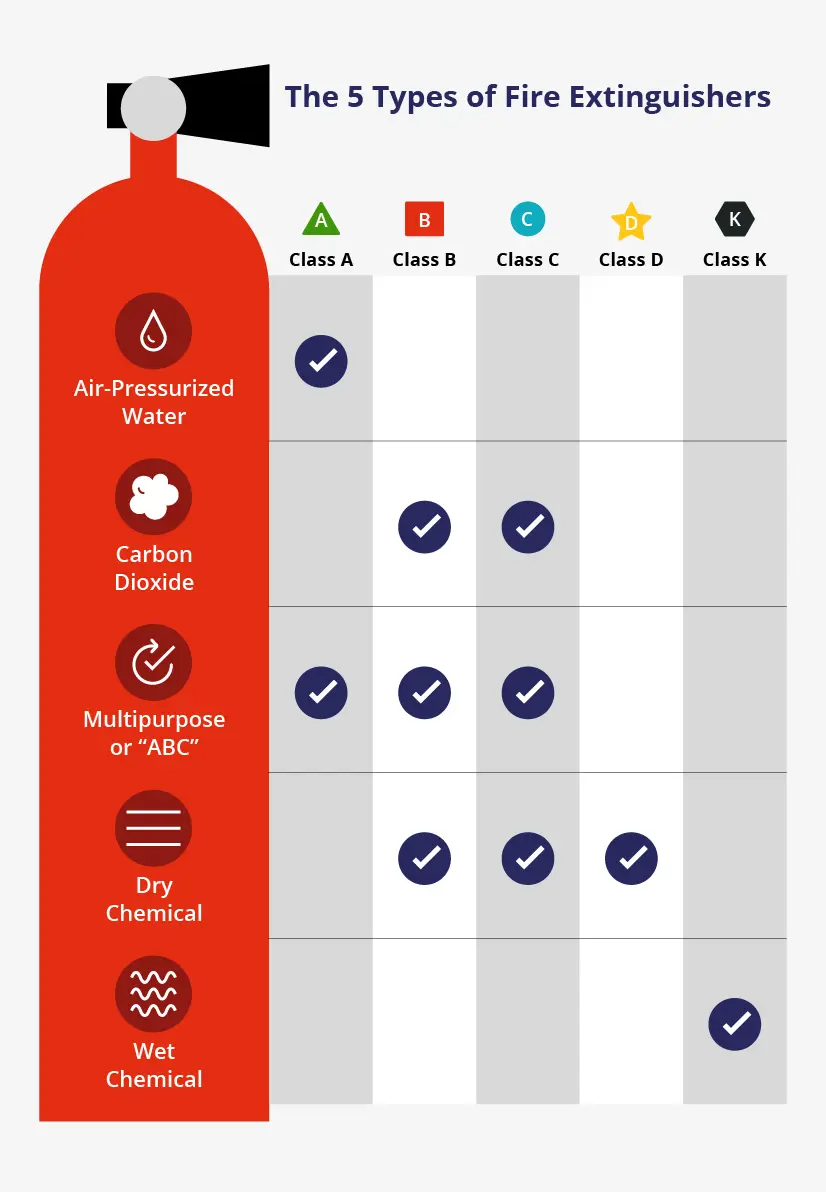
Originally Published February 10, 2015
Rainbow Restoration explains the importance of selecting the correct fire extinguisher for different fire types. Key considerations include:
|
The classes of fire extinguishers and what they’re used for include:
- Class A: Ordinary combustibles
- Class B: Flammable liquids
- Class C: Electrical equipment
- Class D: Combustible metals
- Class K: Cooking oils
When it comes to fire preparation, one of the first lines of defense against potential disasters is a proper fire extinguisher.
In fact, over 85% of building fires could be controlled with a portable fire extinguisher, according to a 2023 data study.
Understanding the different classes of fire extinguishers isn’t just a matter of compliance; it’s a crucial component of risk mitigation.
Learn more about different classes of fire extinguishers and the types of fires they’re intended for so you can check one item off your fire safety checklist.
What Are the Different Types of Fires?
Fires can be categorized into different types based on the materials fueling them and their characteristics. The most common types include:
- Class A fires (ordinary combustibles): These involve the burning of paper, cloth, plastic, wood, and other ordinary materials.
- Class B fires (flammable liquids): These occur when oil, gasoline, grease, paint, and solvents ignite.
- Class C fires (electrical equipment): These happen when faulty wiring, overloaded circuits, malfunctioning computers, or other electrical equipment start a fire.
- Class D fires (metal): These involve combustible metals, such as magnesium, titanium, aluminum, sodium, or potassium. These fires are generally limited to laboratories with these dangerous substances on hand.
- Class K fires (cooking): These ignite in kitchens using hot grease and oil to cook food.
Classes of Fire Extinguishers
Just as there are different types of fires, there are different classes of fire extinguishers designed to put each type of fire out.
While it may seem like any fire extinguisher would help put out a fire, using the wrong fire extinguisher could potentially worsen the fire, create electric shock, or cause additional damage.
Consider the following options when shopping for the right class of fire extinguisher for your home or business.
Class A: Air-Pressurized Water Extinguishers
Use for: Ordinary combustibles
Because it’s so inexpensive and readily available, water is commonly used to put out ordinary Class A fires. These extinguishers are usually silver-colored and stand 2 to 3 feet tall. Some versions have a detergent inside to make the water foam and be more effective at cooling and smothering the flames.
This type of fire extinguisher shouldn’t be used on Class B or C fires as it may worsen the fire or cause electrical shock.
Classes B & C: Carbon Dioxide or Dry Chemical Extinguishers
Use for: Flammable liquids and electrical equipment
Water is not effective for putting out fires caused by flammable liquids or electrical equipment. In fact, water could make matters worse by dispersing the flames over a wider area.
That’s why a CO2 or dry chemical extinguisher is needed for Class B and C fires. The CO2 displaces the oxygen, and its coolness brings the temperature down so the fire can no longer burn.
CO2 fire extinguishers don’t leave a residue behind, which can be useful in protecting expensive equipment.
Classes A, B, & C: Multipurpose or “ABC” Extinguisher
Use for: Ordinary combustibles, flammable liquids, or electrical equipment
In most cases, this is the type of fire extinguisher to have on hand. A single canister can handle the three most common types of fires: Classes A, B, and C.
Multipurpose fire extinguishers are composed of dry chemicals that coat the fire with a retardant power, choking it of oxygen. The dry chemicals also interrupt the chemical reaction required for the fuel source to burn.
These fire extinguishers are the signature red color you’re most familiar with and weigh between 5 and 20 pounds.
Class D: Dry Chemical Extinguisher
Use for: Metal
A dry chemical extinguisher is the only type of extinguisher that should be used on metal fires. It contains a dry powder made of graphite or sodium chloride, which smothers the fire.
The fine powder forms a barrier that prevents the combustible metal from reacting with oxygen and reigniting. It also prevents potential explosions or violent reactions that can occur when water or other standard extinguishing agents come into contact with these highly reactive metals.
Class K: Wet Chemical Extinguishers
Use for: Cooking
Commercial kitchens are required to have Class K fire extinguishers on hand. Because of the high temperature of cooking oils, flames in a deep fryer may continue to blaze, even when a Class B fire extinguisher is used on the flammable liquid. The fine mist in wet chemical extinguishers smothers Class K fires.
How Fire Extinguishers Work
Fire is a fierce chemical reaction that results in light, heat, flames, and smoke. In order to burn, a fire requires three things:
- Oxygen
- Heat
- Fuel source
Portable fire extinguishers are designed to displace one of these requirements by cooling the fuel source, separating the oxygen from the fuel, or stopping the chemical reaction altogether.
How To Choose the Right Fire Extinguisher
Not sure what fire extinguisher is best suited for your situation? Consider these factors:
- Hazard: Identifying the type of hazard that’s most likely to be encountered is the primary consideration in choosing a fire extinguisher. In most cases, the most common hazard is ordinary combustibles like wood or paper, but other hazards like cooking oil or flammable liquids require specific fire extinguishers.
- Size: Fire extinguishers need to be easy to reach and a suitable size to handle the potential fire risk. The most common sizes include:
- 2-pound: Best for vehicles
- 5-pound: Best for offices or homes
- 10-pound: Best for large industrial spaces
- Location: Where you plan to use and place a fire extinguisher is important. For instance, industrial settings may require a dry chemical extinguisher to deal with combustible metals, while a kitchen will require a wet chemical extinguisher since it’s more prone to grease fires. If the wrong type of extinguisher is placed in an area, it may not be effective when a fire breaks out and can lead to increased damage and safety hazards.
- Outdoor use: Be mindful of outdoor use when it comes to types of extinguishers. For instance, CO2 fire extinguishers won’t work as well in windy conditions, and water extinguishers may freeze in cold conditions.
Trust Rainbow Restoration® for Fire Restoration
According to the Insurance Information Institute, property losses from fires total more than $48 billion a year. Selecting the right class of fire extinguishers is crucial for effective fire prevention and damage mitigation. In the unfortunate event of a fire, a reliable fire restoration service can help restore your property and return your home or business to its best possible condition.
In the meantime, learn more about how to use a fire extinguisher to be prepared to swiftly and safely respond to a fire if needed.
This article is intended for general informational purposes only and may not be applicable to every situation. You are responsible for determining the proper course of action for your property. Services should be performed by licensed and experienced professionals. Rainbow Restoration is not responsible for any damages that occur as a result of this blog content or your actions. For the most accurate guidance, contact a Rainbow Restoration professional for a custom, on-site assessment.

